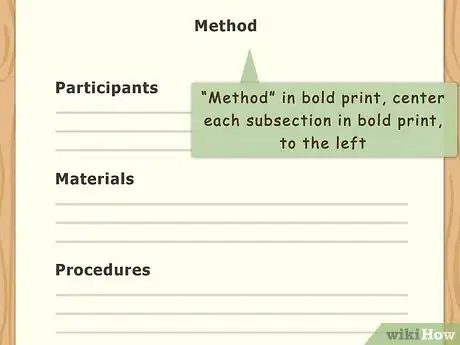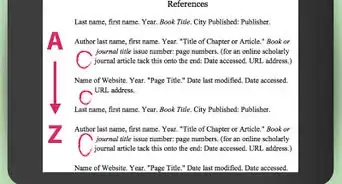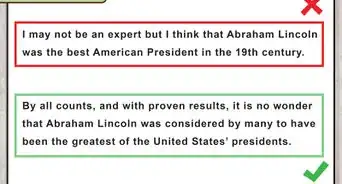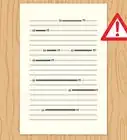This article was co-authored by wikiHow Staff. Our trained team of editors and researchers validate articles for accuracy and comprehensiveness. wikiHow's Content Management Team carefully monitors the work from our editorial staff to ensure that each article is backed by trusted research and meets our high quality standards.
There are 8 references cited in this article, which can be found at the bottom of the page.
wikiHow marks an article as reader-approved once it receives enough positive feedback. In this case, 80% of readers who voted found the article helpful, earning it our reader-approved status.
This article has been viewed 315,178 times.
Learn more...
The American Psychological Association's (APA) method of citation is one of the most widely used styles for writing scientific and research papers, particularly in fields like psychology, sociology, business, economics, and medicine. This style can seem intimidating, but it’s mostly a matter of dividing your paper into the right sections and following basic formatting guidelines. Give your paper a strong intro, then follow up with the methods, results, and discussion sections. Include references, an abstract, and any relevant tables or figures, and you’re good to go!
Steps
Formatting the Title Page and Abstract
-
1Set the basic layout parameters. An APA style paper should use a 12 point font size and be double spaced throughout. One inch margins all around are also recommended. Use this basic layout on every page of your paper.[1]
-
2Dream up a title that’s fairly brief. The APA recommends that titles the short but sweet, and to the point. Ten to twelve words is a good length, and the title should give readers a sense of exactly what your paper is about.[2]
- For instance, a title like “Age, Health, and Cities” is too short and vague.
- ”Age-Based Influences on the Perception of Access to Healthcare in Cities” is more informative.
- Center the title on the page.
Advertisement -
3Include your name and institution below the title. Double-spacing is fine here. There’s no need to include extra spaces between the title and this information. It should look something like this:[3]
- Age as an Influence on Perceived Access to Healthcare in Cities
- Rohanda Jenkins
- University of Toledo
-
4Make use of the page header. Every page of your paper, including the title page, should have a running header. This should be a brief synopsis of your paper’s title. Style it in all caps, and keep it under 50 characters.[4]
- For example, “AGE AND PERCEIVED ACCESS TO HEALTHCARE”
-
5Set the page number in the upper right. The page number should appear on the same line as the running header, all the way to the right. Set the page number to show up automatically on every subsequent page.[5]
Creating the Main Body
-
1Introduce your paper. The first section of an APA style paper will be the introduction, but it doesn’t have to be labeled. Just write the title of your paper (in regular type) on the start of the next page, then begin writing your introduction on the line below it.[6]
- Your introduction should summarize your topic, it’s relevance to other research, and how you arrived at your hypothesis.
- Keep things interesting. Avoid boring your readers with lists like “Schmidt concluded in 2009 that…. As Donaldson conferred in 2011…. In 2013, Pavlov then argued…”
- Instead, write in terms of ideas: “Scholars such as Schmidt and Donaldson have proven that there is widespread variability in access to healthcare. The role of age in creating this variability has not been adequately considered. Knowledge of health care options among the elderly is an important starting point that Pavlov’s research explores, but a more comprehensive study of age-based influences is needed.”
-
2Label the methods section. In bold print, just after your introduction, center the word “Method.” This section is a little easier. It should describe, in simple terms, the exact design of your research. Create subsections to describe the participants, materials, and procedures you used in your study. Do not use page breaks between these subsections or any other sections of your paper).[7]
- Title each subsection (“Participants,” “Materials,” “Procedures”) in bold print, and set the subsection titles all the way to the left. Begin each paragraph on the next line.
- If it is necessary to describe the equipment you used, you can also include an “Apparatus” section instead of or in addition to the “Materials” section.
- The goal of the methods section is to show other researches how to replicate the study, if they wanted to.
-
3Share your results. Put the word “Results” in bold print and center it after the last of your methods subsections. Make sure to include statistics analyzing your study, if applicable.[8]
- Refer to the APA manual or your specific field for precise information on how to format statistics.
- Make references to any supplementary materials you have in your paper (charts, images, graphs, tables, etc.). For example, you might write something like “As Figure 1 indicates…”
-
4Tell readers the significance of your work in the discussion section. Label this section “Discussion” in bold print, centered, just after the results section. Discuss things like whether or not your findings matched your hypothesis (and your guess as to why). Make sure to acknowledge any limits to your study. You can also mention what other scholars might do next based on your findings.[9]
- For example, your discussion might say something “Although this study indicated that teens perceive health care as being less accessible than adults over 35, additional research is needed to explore this topic among 18-35 year olds.”
Applying the Finishing Touches
-
1Tack on the references section. All sources that you use in your study should be cited according to current APA style guidelines. After your discussion section, you should also include a list of full bibliographical information for these references, following the word “References” centered in bold type.[10]
- List the references alphabetically, according to the first author’s last name.
- Don’t put an extra space between each reference. Regular double spacing is all you need.
- Use hanging indentation for the reference entries.
- Make sure to also include APA style in-text citations if you cite a reference in the body of your essay.
-
2Include any tables or figures you created. The formatting of tables and figures varies based on your field as well as the design of your study. Check with the most recent APA style manual or authorities in the field if you want to see recommendations. If you include multiple tables and figures, give each its own page.[11]
- If you are a student, however, your instructor may ask you to incorporate tables or figures into the body of your paper. Always ask if you aren’t sure.
-
3Devote a separate page to the abstract. Write a paragraph that summarizes topic, methods, results, and discussions. Limit it to 150-250 words. Like the rest of your paper, this should be double spaced. It should be block format, however (don’t indent the first line).[12]
- Put the word “Abstract” centered in regular type on the line above the paragraph.
- You should write the abstract after you’re finished with the paper, put position it on its own page just after the title page.
Community Q&A
-
QuestionWhat's the difference between APA and MLA?
 Community AnswerThere are many differences, but the biggest difference is in when each format is used. APA formatting is used for writing papers in the sciences and social sciences, while MLA formatting is intended more commonly for papers written in the humanities/liberal arts areas. As for the formatting itself, MLA formatted papers don't have a title page or abstract while APA papers do. In-text citations in MLA include author and page, while APA citations include author and date. There are differences in the titles and layouts of the reference lists for each type of paper. This is just a sampling, reviewing the style manuals for each will reveal many other differences.
Community AnswerThere are many differences, but the biggest difference is in when each format is used. APA formatting is used for writing papers in the sciences and social sciences, while MLA formatting is intended more commonly for papers written in the humanities/liberal arts areas. As for the formatting itself, MLA formatted papers don't have a title page or abstract while APA papers do. In-text citations in MLA include author and page, while APA citations include author and date. There are differences in the titles and layouts of the reference lists for each type of paper. This is just a sampling, reviewing the style manuals for each will reveal many other differences. -
QuestionHow do I do APA in a summary paper?
 KohnjaCommunity AnswerThe summary paper should have a cover page, but does not need an abstract or a reference page. All APA rules will remain the same other than that.
KohnjaCommunity AnswerThe summary paper should have a cover page, but does not need an abstract or a reference page. All APA rules will remain the same other than that. -
QuestionDo I need to indicate the textbook page when I found it on an APA style paper?
 Community AnswerThe only time pages are required for APA style papers are when you are using a direct quote. Purdue Owl has a good website for many of the basics to APA style.
Community AnswerThe only time pages are required for APA style papers are when you are using a direct quote. Purdue Owl has a good website for many of the basics to APA style.
References
- ↑ https://owl.purdue.edu/owl/research_and_citation/apa6_style/apa_formatting_and_style_guide/general_format.html
- ↑ https://apastyle.apa.org/style-grammar-guidelines/paper-format/title-page
- ↑ https://owl.purdue.edu/owl/research_and_citation/apa6_style/apa_formatting_and_style_guide/general_format.html
- ↑ https://owl.purdue.edu/owl/research_and_citation/apa6_style/apa_formatting_and_style_guide/general_format.html
- ↑ https://owl.purdue.edu/owl/research_and_citation/apa6_style/apa_formatting_and_style_guide/general_format.html
- ↑ https://owl.purdue.edu/owl/research_and_citation/apa_style/apa_style_introduction.html
- ↑ https://www.canadacollege.edu/htpcommittee/docs/GUIDELINES%20FOR%20RESEARCH%20PAPER%20S14.pdf
- ↑ https://www.canadacollege.edu/htpcommittee/docs/GUIDELINES%20FOR%20RESEARCH%20PAPER%20S14.pdf
- ↑ https://apastyle.apa.org/instructional-aids/discussion-phrases-guide.pdf
About This Article
To write an APA-style paper, use a 12-point font size, double spacing, and 1-inch margins all around. You should also include a title page with the title of your paper and your name and institution. Also, include a page header at the top of every page that gives a brief synopsis of your paper's title in under 50 characters. At the end of your paper, make a "References" page that contains all of the sources you used in alphabetical order according to the author's last name. To learn how to write and format the body of an APA-style paper, scroll down!











































































